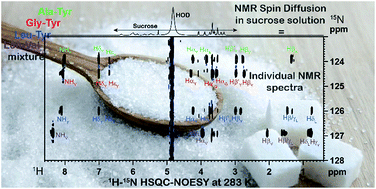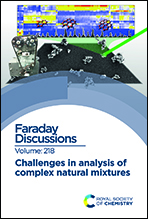Polar mixture analysis by NMR under spin diffusion conditions in viscous sucrose solution and agarose gel†
Abstract
The use of two new viscous solvents, sucrose solution and agarose gel, is reported for the first time for giving access to the individual NMR spectra of polar and potentially bioactive compounds in a mixture. Under viscous conditions, the tumbling rate of small and mid-sized molecules reduces in solution, so that the longitudinal cross-relaxation encourages the observation of spin diffusion. As a result, all of the resonances of the 1H nuclei within the same molecule tend to correlate together in a 2D NOESY spectrum, thus paving the way to mixture analysis. This work describes the individualization of four structurally close mixed dipeptides: Leu–Val, Leu–Tyr, Gly–Tyr and Ala–Tyr dissolved in each of sucrose solution and agarose gel, by means of spin diffusion in homonuclear selective 1D NOESY, selective 2D NOESY experiments and heteronuclear 2D HSQC-NOESY. Sucrose solution should be preferred to agarose gel for the investigation of mixtures made of small and flexible polar compounds, due to its capability to give rise to more suitable viscous conditions mandatory for efficient spin diffusion, even though agarose gel reveals the benefit of not offering intense residual solvent proton signals due to active transverse relaxation.

- This article is part of the themed collection: Challenges in analysis of complex natural mixtures


 Please wait while we load your content...
Please wait while we load your content...